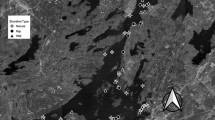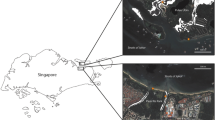Abstract
We evaluated two marsh terracing restoration projects (GI=Galveston Island State Park, PM=Pierce Marsh) to compare nekton density and biomass between locations and among habitat types (open water pre-construction, open water post-construction, terrace marsh, terrace pond). Most (72%) animals collected were decapod crustaceans. Few differences in nekton abundance were observed over time (pre-construction versus post-construction open water). Comparisons of pre-construction to post-construction open water showed that the locations differed environmentally (e.g., turbidity) and in populations of nekton species. Density and biomass of gulf menhaden Brevoortia patronus and spot Leiostomus xanthurus in spring and density of white shrimp Litopenaeus setiferus in fall were higher at PM than GI, whereas densities and biomass of blue crab Callinectes sapidus, density of pink shrimp Farfantepenaeus duorarum, and biomass of brown shrimp Farfantepenaeus aztecus in the fall were higher at GI than PM. Despite location differences, constructing terraces appeared to benefit fishery species at both locations. Densities of brown shrimp, blue crab, white shrimp (fall), and pink shrimp (fall) and the biomass of brown shrimp, blue crab, and white shrimp (fall) were higher in terrace marsh than open water. Marsh terracing appears to be an effective tool for enhancing fishery habitat in degraded coastal systems.




Similar content being viewed by others
References
Abele L, Kim W (1986) An illustrated guide to the marine decapod crustaceans of Florida, Part 1. State of Florida, Department of Environmental Regulation, Technical Series 8(1)
Adams DC, Anthony CD (1996) Using randomization techniques to analyze behavioral data. Anim Behav 51:733–738
Akin S, Winemiller KO, Gelwick FP (2003) Seasonal and spatial variations in fish and macrocrustacean assemblage structure in Mad Island Marsh estuary, Texas. Estuar Coast Shelf Sci 57:269–82
Barras, J, Beville S, Britsch D et al (2003) Historical and projected coastal Louisiana land changes: 1978–2050: USGS Open File Report 03-334 39 p revised Jan 2004
Beck MW, Heck KL Jr, Able KW et al (2001) The identification, conservation, and management of estuarine and marine nurseries for fish and invertebrates. Bioscience 51:633–641
Christmas, JY, McBee JT, Waller RS, Sutter III FC (1982) Habitat suitability index models: gulf menhaden. U.S. Department of Interior, Fish and Wildlife Service. FWS/OBS-82/10.23
Heard RW (1982) Guide to common tidal marsh invertebrates of the northeastern Gulf of Mexico. Mississippi-Alabama Sea Grant Consortium, Ocean Springs
Hoese HD, Moore RH (1998) Fishes of the gulf of Mexico, 2nd edn. Texas A&M University Press, College Station
Howe JC, Wallace RK, Rikard FS (1999) Habitat utilization by postlarval and juvenile penaeid shrimps in Mobile Bay, Alabama. Estuaries 22:971–979
Hurlberg SH (1984) Pseudoreplication and the design of ecological field experiments. Ecol Monogr 54:187–211
Jordan SJ, Smith LM, Nestlerode JA (2009) Cumulative effects of coastal habitat alterations on fishery resources: toward prediction at regional scales. Ecol Soc 14:16
King SP, Sheridan P (2006) Nekton of new seagrass habitats colonizing a subsided salt marsh in Galveston Bay, Texas. Estuaries Coasts 29:286–296
La Peyre MK, Gossman B, Nyman JA (2007) Assessing functional equivalency of nekton habitat in enhanced habitats: comparison of terraced and unterraced marsh ponds. Estuaries Coasts 30:526–536
Livingston RJ (1997) Trophic response of estuarine fishes to long-term changes in river runoff. Bull Mar Sci 60:984–1004
McEachran JD, Fechhelm JD (1998) Fishes of the Gulf of Mexico, Vol 1: myxiniformes to gasterosteiformes. University of Texas Press, Austin
McIvor CC, Odum WE (1988) Food, predation risk, and microhabitat selection in a marsh fish assemblage. Ecology 69:1341–1351
Minello TJ (1999) Nekton densities in shallow estuarine habitats of Texas and Louisiana and the identification of essential fish habitat. Am Fish Soc Symp 22:43–75
Minello TJ, Rozas LP (2002) Nekton in Gulf Coast wetlands: fine-scale distributions, landscape patterns, and restoration implications. Ecol Appl 12:441–455
Minello TJ, Zimmerman RJ (1992) Utilization of natural and transplanted Texas salt marshes by fish and decapod crustaceans. Mar Ecol Prog Ser 90:273–85
Minello TJ, Webb JW Jr (1997) Use of natural and created Spartina alterniflora salt marshes by fishery species and other aquatic fauna in Galveston Bay, Texas, USA. Mar Ecol Prog Ser 151:165–179
Minello TJ, Able KW, Weinstein MP, Hays CG (2003) Salt marshes as nurseries for nekton: testing hypotheses on density, growth, and survival through meta-analysis. Mar Ecol Prog Ser 246:39–59
Moksnes PO, Lipcius RN, Pihl L, van Montfrans J (1997) Cannibal-prey dynamics in young juveniles and postlarvae of the blue crab. J Exp Mar Biol Ecol 215:157–187
Orlando SP Jr, Rozas LP, Ward GH, Klein CJ (1991) Analysis of salinity structure and stability for Texas estuaries. Strategic Assessments Branch, NOS/NOAA, Rockville
Peterson GW, Turner RE (1994) The value of salt marsh edge vs interior as a habitat for fish and decapod crustaceans in a Louisiana tidal marsh. Estuaries 17:235–262
Rakocinski CF, Baltz DM, Fleeger JW (1992) Correspondence between environmental gradients and the community structure of marsh-edge fishes in a Louisiana estuary. Mar Ecol Prog Ser 80:135–48
Rice WR (1989) Analyzing tables of statistical tests. Evolution 32:223–225
Richards WJ (ed) (2005) Early stages of Atlantic fishes: an identification guide for the Western Central North Atlantic, volumes 1 and 2. CRC, Boca Raton
Rozas LP, Minello TJ (2001) Marsh terracing as a wetland restoration tool for creating fishery habitat. Wetlands 21:327–341
Rozas LP, Minello TJ (2007) Restoring coastal habitat using marsh terracing: the effect of cell size on nekton use. Wetlands 27:595–609
Rozas LP, Minello TJ (2009) Using nekton growth as a metric for assessing habitat restoration by marsh terracing. Mar Ecol Prog Ser 394:179–193
Rozas LP, Caldwell P, Minello TJ (2005) The fishery value of salt marsh restoration projects. J Coast Res 40:37–50
Rozas LP, Minello TJ, Zimmerman RJ, Caldwell P (2007) Nekton populations, long-term wetland loss, and the effect of recent habitat restoration in Galveston Bay, Texas, USA. Mar Ecol Prog Ser 344:119–130
Scheiner SM, Gurevitch J (2001) Design and analysis of ecological experiments. Oxford University Press, New York
Stickney RR, Cuenco ML (1982) Habitat suitability index models: juvenile spot. U.S. Department of Interior, Fish and Wildlife Service. FWS/OBS-82/10.20. 12 pp
Texas General Land Office, Texas Natural Resource Conservation Commission, Texas Parks and Wildlife Department, US Fish and Wildlife Service, National Oceanic and Atmospheric Administration (1997) Restoration plan/ environmental assessment for the Apex Barges oil spill, July 28, 1990. Available at http://www.gc.noaa.gov/natural-office2.html. Accessed 9 Dec 2008
Thom CSB, La Peyre MKG, Nyman JA (2004) Evaluation of nekton use and habitat characteristics of restored Louisiana marsh. Ecol Eng 23:63–75
Turner RE, Streever B (2002) Approaches to coastal wetland restoration: northern Gulf of Mexico. SPB Academic, The Hague
Underwood SG, Steyer GD, Good B, Chambers D (1991) Bay bottom terracing and vegetative planting: an innovative approach for habitat and water quality enhancement. In: Webb FJ Jr (ed) Annual conference on wetlands restoration and creation. Hillsborough Community College, Tampa, pp 164–73
White WA, Tremblay TA (1995) Submergence of wetlands as a result of human-induced subsidence and faulting along the upper Texas Gulf Coast. J Coast Res 11:788–807
White WA, Tremblay TA, Wermund EG Jr, Handley LR (1993) Trends and status of wetland and aquatic habitats in the Galveston Bay system, Texas. Galveston Bay National Estuary Program. Webster, TX GBNEP-31
White WA, Tremblay TA, Waldinger RL, Calnan TR (2004) Status and trends of wetlands and aquatic habitats on barrier islands, upper Texas Coast. Galveston and Christmas Bays. Final report to the Texas general land office and NOAA. Texas Bureau of Economic Geology, Austin
Williams AB (1984) Shrimps, lobsters, and crabs of the Atlantic coast of the Eastern United States, Maine to Florida. Smithsonian Institution, Washington, DC
Zimmerman RJ, Minello TJ, Zamora G (1984) Selection of vegetated habitat by brown shrimp, Penaeus aztecus, in a Galveston Bay salt marsh. Fish Bull 82:325–336
Acknowledgments
Funding for this research was provided by the NOAA Fisheries Service Restoration Center and Southeast Fisheries Science Center. The research was conducted through the NOAA Fisheries Service Southeast Fisheries Science Center by personnel from the Fishery Ecology Branch located at the Galveston Laboratory and the Estuarine Habitats and Coastal Fisheries Center in Lafayette, LA. In particular, field and laboratory assistance was provided by Philip Caldwell, Harley Clinton, Molly Dillender, Jim Ditty, Jennifer Doerr, Shawn Hillen, Joni Kernan, Kirk Kilfoyle, Seth King, Genni Miller, Freddie Nix, Matt Prine, Juan Salas, Katie Turner, Katrinyda Williams, and Elizabeth Wilson. The findings and conclusions in this report are those of the authors and do not necessarily represent the views of the NOAA Fisheries Service.
Author information
Authors and Affiliations
Corresponding author
Rights and permissions
About this article
Cite this article
Merino, J.H., Rozas, L.P., Minello, T.J. et al. Effects of Marsh Terracing on Nekton Abundance at Two Locations in Galveston Bay, Texas. Wetlands 30, 693–704 (2010). https://doi.org/10.1007/s13157-010-0079-x
Received:
Accepted:
Published:
Issue Date:
DOI: https://doi.org/10.1007/s13157-010-0079-x




